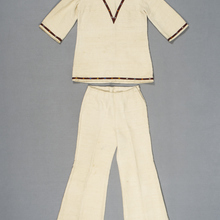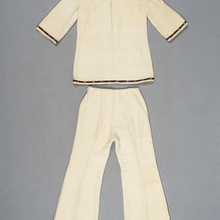Garment
MOA: University of British Columbia
3188/12 a-b
Hand woven tunic (part a) and pants (part b) made of thick unbleached and undyed cotton. Tunic is long, with three quarter sleeves, a high neck, and zipper closure at back. At hem and wrists, as well as in a deep ‘v’ on shoulders and chest are attached thin bands of embroidery, consisting of evenly spaced diamonds in a variety of colours interspersed with ‘v’ shapes in black and red. Pants are narrow through the hips and thighs and widen toward ankles, constructed with seams down the back of each leg and several short pleats at waistband. Closure is by side zipper. Pants are undecorated.
-
History Of Use
Modern traditional clothing; worn during events and holidays. Embroidered white cotton pants and tunic, worn by men. The style of embroidery indicates that the clothing is likely from the Oromo people, although white cotton clothing can be found throughout Ethiopia (Chane, 2019). The weaving techniques and embroidery used in Ethiopian textiles are reminiscent of early cultural exchange and trade between Ethiopia and its neighbouring countries. Records show that as early as the first century CE, cotton was being imported into Ethiopia via the Red Sea. For the first few centuries, cotton clothing was restricted to aristocracy, but over time it became prolific throughout Ethiopian society (Gillow, 2009).
-
Cultural Context
Machine-made fabric; sewn by both men and women.
- Type of Item garment
- Culture Oromo
- Material cotton fibre, dye, metal
- Measurements height 80.5 cm, width 93.5 cm (part a) height 107.0 cm, width 61.0 cm (part b)
- Previous Owner Edward Harvey, Lorna Marsden
- Received from Edward Harvey, Lorna Marsden
- Made in Ethiopia
- Creation Date between 1971 and 1975
- Ownership Date before July 15, 2016
- Acquisition Date on July 15, 2016
- Item Classes textiles
- Condition good
- Accession Number 3188/0012 a-b

